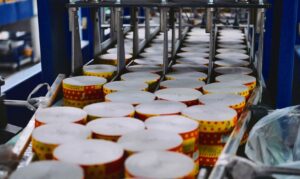
Ukrainian enterprises are now producing two thousand lower limb prostheses and 200 upper limb prostheses in one month, according to Oksana Zholnovych, Minister of Social Policy of Ukraine.
“On average, according to the statistics collected, all enterprises produce more than 2,000 lower limb prostheses and about 200 upper limb prostheses per month,” Zholnovych said during a national telethon on Wednesday.
According to her, almost 80 enterprises are engaged in the production of prostheses in Ukraine, while at the beginning of the full-scale invasion there were about 40 of them. The head of the department also noted that not only the number of enterprises has increased, but also the production volumes of the previously operating ones.
“They are now working to the maximum. I think they will continue to expand. But I would not say that there are long waiting lists (for prostheses – IF-U),” the minister added.
Zholnovych also noted that over 20 thousand people, both civilians and military, have been prosthetized in Ukraine over the past two years.
As reported, in October, the website of the Ministry of Social Policy launched an information panel with a list of prosthetic companies and other manufacturers of rehabilitation aids.

In January-October, Papir-Mal Cardboard and Paper Mill (Malyn, Zhytomyr region) produced products worth UAH 382.5 million, which is almost 2.2 times higher than the same figure for the first 10 months of 2022.
According to UkrPapir Association statistics provided to Interfax-Ukraine, the growth in production volumes was primarily driven by a more than 2.2-fold increase in the production of containerboard (including corrugated paper), up to 57.8 thousand tons.
As reported, last year the plant put into operation a second cardboard machine with a production capacity of 800 m/min (twice as much as the first one).
In addition, in January-October, the company produced 4.1 thousand tons of base paper for sanitary products, up 19%, and 22.3 million rolls of toilet paper, up 43.8%.
According to statistics, in October, Papir Mal increased its paper and cardboard production by 20.2% compared to October 2022, to 6.4 thousand tons, which is 4.8% less than in September this year.
The company specializes in the production of sanitary paper products and packaging cardboard (liner and fluting).
According to UkrPapir, the company’s production volume in 2022 decreased by 4.7% compared to 2021, to UAH 247 million.

In January-October 2023, Ruta, a major Ukrainian manufacturer of sanitary and hygienic paper products, whose management company is VGP JSC (Lutsk), produced UAH 1 billion 345.6 million worth of products, which is 83.8% more than in the same period in 2022.
According to UkrPapir’s statistics provided to Interfax-Ukraine, the company has thus slowed down the growth rate of production in monetary terms slightly compared to the same period last year: in nine months, the figure was 90%, and in eight months, 97.1%.
In terms of volume, the company’s production of toilet paper in rolls increased by 47% to 111.3 million units, which is still the third best result in the industry after Kyiv Cardboard and Paper Mill (213.3 million units) and Kokhava Paper Mill (113 million units).
The company produces pulp-based sanitary and hygiene products from imported base paper.
VGP’s brand portfolio includes napkins, toilet paper, paper handkerchiefs, and kitchen towels under the Ruta, Ruta Selecta, Fesko, Nosovic, Polotenchko, 100% paper, Servetta, and Ecolo brands. The assortment includes more than 180 items.
As reported with reference to Ukrpapir’s data, in 2022, VGP JSC produced products worth UAH 977.61 million, which is 2.8% more than a year earlier. At the same time, according to the company’s report, in physical terms (tons), production decreased by 27% due to the loss of some markets with the beginning of Russia’s military aggression in Ukraine.
Exports accounted for more than a quarter of sales in 2022. The paper used as the basis for production was purchased mainly in Turkey and Romania.

Cardboard and Paper Company LLC (Lviv), a major Ukrainian manufacturer of cardboard tubes and sanitary products, increased its production by 11.5% in January-October 2023, up to UAH 1 billion 070.5 million, compared to the same period in 2022.
According to UkrPapir Association statistics provided to Interfax-Ukraine, the company increased its output of cardboard products by 3.4% to 22.7 thousand tons and of base paper for sanitary products by 12.5% to 6.5 thousand tons in physical terms. Production of toilet paper in rolls increased by 52.3% to 5.13 million units.
At the same time, in October, the company increased its paper and cardboard production by 36% compared to the same month last year, to 3.04 thousand tons, which is 2.7% less than in September this year.
LLC “Cardboard and Paper Company” produces products and semi-finished products from waste cardboard (cardboard sheets, corners, sleeves), cellulose and recycled waste paper (toilet paper, towels, napkins TM Papero). The company supplies its products, in particular, to the EU countries.
Among its customers are Biosphere and Arterium corporations, Nestle, Khlibprom, and Yarych confectionery.
As reported, in 2022, the factory increased its commercial output by 51.5% compared to 2021, up to UAH 1 billion 186 million, without stopping work during the year. Net profit tripled to UAH 263.7 million.

In January-October 2023, Zhydachiv Pulp and Paper Mill (ZhPPM, Lviv region) produced products worth UAH 444.6 million, up 7.6% year-on-year.
According to statistics provided to Interfax-Ukraine by UkrPapir Association, in physical terms, corrugated packaging output increased by 21.2% to 19.2 million square meters, containerboard by almost 27% to 13.5 thousand tons, and paper by 11% to 3.7 thousand tons.
In particular, in October, the plant increased production of paper and cardboard by 66.4% to 1.8 thousand tons by October 2022, and corrugated packaging by 54.6% to 2.3 million square meters. Compared to September this year, paper and cardboard production increased by 15.4%, and corrugated packaging by 23%.
Zhytomyr Pulp and Paper Mill has a paper production capacity of 43 thousand tons per year (base paper for corrugation, linerboard, cover paper), cardboard production capacity of 50 thousand tons, corrugated cardboard and corrugated packaging capacity of 120 million square meters, and injection molded containers (tray for 30 eggs) capacity of 72 million units per year.
As reported with reference to the association’s data obtained from the main industry enterprises, over ten months in Ukraine, there was an increase in the production of paper and cardboard by 11.4% (up to 454.9 thousand tons), cardboard boxes – by 18.1% (up to 428.7 million square meters).
In 2022, Zhydachiv Pulp and Paper Mill produced goods worth UAH 510.8 million, up 23.1% year-on-year, with net profit increasing by 67.5% to UAH 41.76 million.

In January-October 2023, Kokhavyno Paper Mill (KBF, Lviv region), which produces sanitary paper products, increased its production by 22.5% compared to the same period in 2022, to UAH 959.6 million, according to statistics from UkrPapir Association.
According to the data provided to Interfax-Ukraine, in physical terms, the production of paper base for sanitary products increased by 2.4% to 34.6 thousand tons. In particular, in October, its output increased by 3.4% to 3.64 thousand tons by October 2022, which is also 23.4% more than in September this year.
The production of toilet paper in rolls increased by 3.9% to 113 million units during this period. KPF retains the second place in terms of its output after Kyiv CPP (213.3 million units), slightly ahead of VGP JSC (TM Ruta).
Kokhava Paper Mill, which has been operating since 1939, produces the base paper for sanitary and hygiene products, as well as toilet paper and paper towels.
The mill has practically not stopped production since the beginning of Russia’s full-scale aggression in Ukraine.
As reported, in 2023, KPF produced products worth UAH 975.3 million, up 44.8% year-on-year. Net profit decreased by 12.7% to UAH 52.4 million.